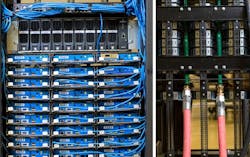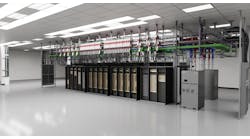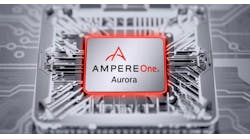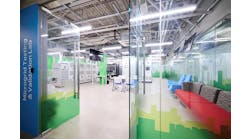It seems that it’s Open Compute Project week in New Mexico. Facebook, the driving force behind the open source hardware movement, said Wednesday that it will build a new data center in Las Lunas, New Mexico.
Today Albuquerque-based Aquila Systems introduced a new server offering warm-water liquid cooling for hyperscale data centers using Open Compute designs.
Aquila, an IT integrator with experience in high performance computing for defense clients, has teamed with Clustered Systems, a cooling specialist that grabbed headlines for winning a 2010 “chill-off” between cooling vendors.
The result is the Aquarius Server, which fits rack designs for the Open Compute Project (OCP). Aquila hopes the server’s combination of extreme power density and efficient cooling can win business in the high performance computing (HPC) market.
Will Hyperscale Go Liquid
Clustered Systems CEO Phil Hughes believes the immense scale of today’s hyperscale data centers portends a shift to higher-density racks. The Aquarius design can support workloads of 50 kW to 60 kW per rack.
“Compute power requirements for HPC, mobility, OpenStack, and SDN data center applications continue to escalate the need for solutions that address density,” said Hughes. “And data centers cooled with air in a conventional fashion have fundamental restrictions on power density. Warm water liquid cooling has none of these restrictions and can be packed very densely, without a need for specialized building. In addition to a reduction in overall expense, an organization is not burdened with a large, slow-to-depreciate property. Our servers provide the lowest CapEx and OpEx in the industry.”
The Aquarius server rack.
A number of liquid cooling vendors use a water-cooled heat sink atop the processor, while others offer immersion cooling, in which entire server chassis are housed in coolant. Clustered Systems has taken a different approach, using water piping to cool a flat plate atop the components.
One key to the system’s efficiency is that it removes the need for cooling equipment, including fans on the servers and chillers to refrigerate water. Like other in-rack cooling solutions, it removes the need for room-level AC or raised floors.
Licensing Cooling Innovation
The Clustered Systems cooling tech has been used in a high-density rack installation at the Stanford Linear Accelerator Center (SLAC) and also by Emerson Network Power in its XDS systems.
Clustered Systems doesn’t build its own servers, but is an engineering firm that licenses its designs to other companies. It’s found an enthusiastic partner in Aquila and its interest in Open Compute.
The Aquarius rack features an OCPV2 form factor, with three servers on each tray. and is able to directly attach to existing warm water infrastructure at datacenter facilities. Aquarius solutions can run off the warm water exhaust of chiller doors, allowing for additional server expansion where traditional cooling infrastructure is already at full capacity.
‘Air is Pervasive’
Advocates of liquid cooling have predicted that data centers would begin to use liquid cooling, which has primarily been used in high performance computing applications in universities and government labs. This shift has yet to occur in a major way, but Hughes sees broader adoption for Clustered’s technology.
“I think this was ahead of its time,” he said. “The issue is that air (cooling) is pervasive. Every data center manager is comfortable with air, and has a ton of expertise in that area. The place we have to go first is where there’s no alternative, which is HPC today.”
Aquila is familiar with liquid cooling from its work in HPC. The company’s New Mexico neighbors include the Department of Energy labs at Los Alamos and Sandia.
Bob Bolz, head of HPC and Data Center Business Development at Aquila, says air cooling can be a challenge in New Mexico. “Here at altitude, you have to move a lot of air to cool equipment,” said Bolz.
“I think there’s a lot of impetus (for hyperscale data centers) to move towards liquid cooling,” said Bolz. “We could save up to 50 percent in the power cost of a data center, and drastically increase the density. There’s no need for raised floors or ambient cooling. We’ve eliminated the need for fans and individual power supplies.”
Alas, Facebook said yesterday that it will use indirect evaporative cooling for its data center in Las Lunas. But Aquila is convinced that a new paradigm is inevitable.
“The drive towards Exascale computing requires cooling the next generation of extremely hot CPUs, while staying within a manageable power envelope,” said Bolz. “Liquid cooling holds the key.”






